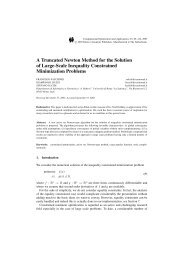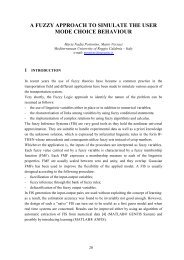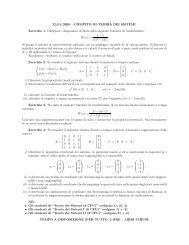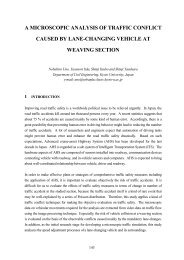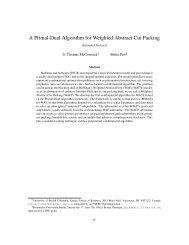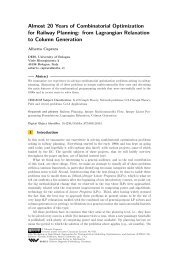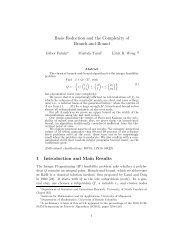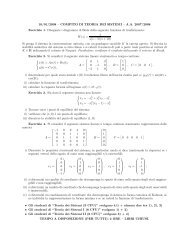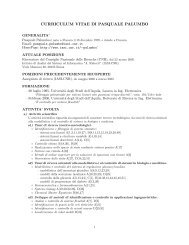OVERVIEW OF ROAD AND MOTORWAY TRAFFIC ... - Iasi.cnr.it
OVERVIEW OF ROAD AND MOTORWAY TRAFFIC ... - Iasi.cnr.it
OVERVIEW OF ROAD AND MOTORWAY TRAFFIC ... - Iasi.cnr.it
Create successful ePaper yourself
Turn your PDF publications into a flip-book with our unique Google optimized e-Paper software.
Overview of road and motorway traffic control strategies 41<br />
lead (due to the absence of real-time measurements) e<strong>it</strong>her to overload of the mainstream<br />
flow (congestion) or to underutilization of the freeway. In fact, ramp metering is an<br />
efficient but also delicate control measure. If ramp metering strategies are not accurate<br />
enough, then congestion may not be prevented from forming, or the mainstream capac<strong>it</strong>y<br />
may be underutilized (e.g. due to groundlessly strong metering).<br />
3.3. Reactive Ramp Metering Strategies<br />
Reactive ramp metering strategies are employed at a tactical level, i.e. in the aim of keeping<br />
the freeway traffic cond<strong>it</strong>ions close to pre-specified set values, based on real-time<br />
measurements.<br />
Local ramp metering. Local ramp metering strategies make use of traffic<br />
measurements in the vicin<strong>it</strong>y of a ramp to calculate su<strong>it</strong>able ramp metering values. The<br />
demand-capac<strong>it</strong>y and occupancy strategies [19] are based on an open-loop disturbancerejection<br />
policy and are qu<strong>it</strong>e popular in North America. An alternative, closed-loop ramp<br />
metering strategy (ALINEA), suggested in [20] is based on classical feedback concepts and<br />
is qu<strong>it</strong>e popular in Europe. Comparative field trials have been conducted in various<br />
countries to assess and compare the efficiency of local ramp metering strategies, see e.g.<br />
[21], whereby ALINEA outperformed feedforward-based strategies w<strong>it</strong>h respect to all<br />
evaluation cr<strong>it</strong>eria.<br />
Multivariable regulator strategies. Multivariable regulators for ramp metering pursue<br />
the same goals as local ramp metering strategies but they make use of all available<br />
mainstream measurements on a freeway stretch to calculate simultaneously the ramp<br />
volume values for all controllable ramps included in the same stretch [22]. The<br />
multivariable regulator strategy METALINE may be viewed as a generalisation and<br />
extension of ALINEA. Field trials and simulation results comparing the efficiency of<br />
METALINE versus ALINEA lead to the following conclusions:<br />
• While ALINEA requires hardly any design effort, METALINE application calls for<br />
a rather sophisticated design procedure that is based on advanced control-theoretic<br />
methods (LQR optimal control).<br />
• For urban freeways w<strong>it</strong>h a high dens<strong>it</strong>y of on-ramps, METALINE was found to<br />
provide no advantages over ALINEA (the latter implemented independently at each<br />
controllable on-ramp) under recurrent congestion.<br />
• In the case of non-recurrent congestion (e.g. due to an incident), METALINE<br />
performs better than ALINEA due to more comprehensive measurement<br />
information.<br />
Corridor impact. Some system operators hes<strong>it</strong>ate to apply ramp metering because of<br />
the concern that congestion may be conveyed from the freeway to the adjacent street<br />
network. In fact, a ramp metering application designed to avoid or reduce congestion on<br />
freeways may have both pos<strong>it</strong>ive and negative effects on the adjacent road network traffic.<br />
However, if an efficient control strategy is applied for ramp metering, the freeway<br />
throughput will be generally increased. More precisely, ramp metering at the beginning of<br />
the rush hour may lead to on-ramp queues in order to prevent congestion to form on the<br />
freeway, which may temporarily lead to diversion towards the urban network. But due to<br />
congestion avoidance or reduction, the freeway will be eventually enabled to accommodate<br />
a higher throughput, thus attracting drivers from urban paths and leading to an improved



